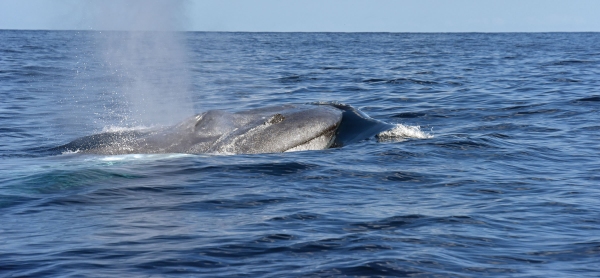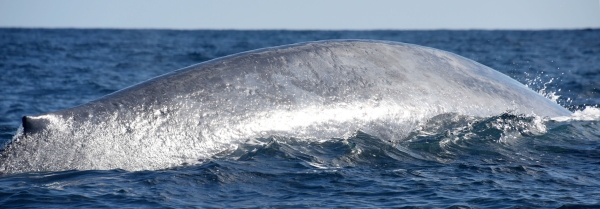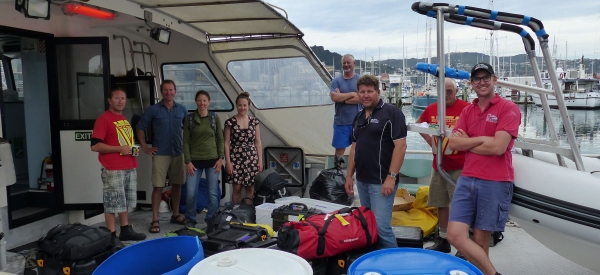
The issue
There are two subspecies of blue whales recognized in the Southern Hemisphere – the Antarctic blue whale (Balaenoptera musculus intermedia) and the pygmy blue whale (B. m. brevicauda). Although research suggests that both sub-species are present in New Zealand waters pygmy blue whales are thought to predominate the Taranaki and greater Cook Strait region (between the North and South Islands). The New Zealand Threat Classification system classifies pygmy blue whales as ‘migrant’ while the International Union for Conservation of Nature considers this sub-species ‘data-deficient’. To date, little is known about the distribution and seasonal movements of pygmy blue whales in any part of the world, including New Zealand.

Pygmy blue whales around New Zealand are differentiated from other populations by a unique call type that was first described in 1967. Through observations of feeding behaviour, recordings of feeding calls, verification of krill presence, and the observation of mother-calf pairs, this region is thought to provide important habitat for the species. However, additional research shows that pygmy blue whales are distributed widely around New Zealand and opportunistic photo-identification and acoustic recordings have identified other potential feeding locations. Therefore, while the South Taranaki Bight provides important habitat for pygmy blue whales, movement data from this sub-species is needed to assess the overall importance of this region relative to other areas. The aim of this voyage was to examine the movement and habitat utilization of pygmy blue whales in New Zealand waters.
The approach
We conducted visual surveys for blue whales from 28 January to 10 February 2018. Due to the limited time available, survey effort was initially focused in the Taranaki region due to a previously described high density of blue whale sightings in the area.

The research team consisted of Kimberly Goetz (NIWA, voyage leader), Simon Childerhouse (Blue Planet Marine, tagger), Dave Paton (Blue Planet Marine, small boat driver), Mike Ogle (Department of Conservation, biopsy collector), and Krista Hupman (NIWA, photo-identification).
A biopsy was only attempted after tag attachment or when conditions were not suitable for tagging. Because there is often only one chance to get within 10 m of a blue whale, the tasks were prioritized as follows: 1) tag deployment, 2) biopsy sample, 3) photo-identification.
The results
Between 28 January and 10 February 2018, the National Institute of Water and Atmospheric Research and collaborators conducted a voyage to attach satellite tracking devices to pygmy blue whales in the Taranaki region of New Zealand. The aim of this voyage was to examine the movement and habitat utilization of pygmy blue whales in New Zealand waters. In total, we spent 72.51 hours (1637.54 km) actively searching for blue whales over eight survey days (several days were lost due to storm events).
Eleven blue whale sighting events were made (16 animals). Two blue whales were sighted twice, meaning that a total of 14 unique individuals were encountered. Other sightings included Bryde’s (possibly sei) whales, common dolphins, Hector’s dolphins, and fur seals.
Two satellite tags were successfully deployed and six skin/blubber samples were collected from four blue whales. Photo-identification data were collected for eight individual blue whales.

Overall, blue whales were found further south, in lower numbers, and were not observed surface feeding, likely due to the La Niña anomalous oceanographic conditions. This resulted in warmer temperatures (4-6 °C higher than average climatology), reduced west wind flows, and consequent reduction in upwelling, significantly impacting the high productivity characteristic of the Taranaki region.
To date, tracking data collected from two blue whales tagged in New Zealand waters did not spend much time in the Taranaki region. One animal travelled north before transmissions ceased on 14 February off the west coast of the North Island, near Auckland, and the other animal circumnavigated the entire South Island as of 27 March. Due to low sample size and La Niña conditions, we do not know how representative these movements are for blue whales in New Zealand waters.
All photo-identification data will be provided to a collaborative Southern Hemisphere Blue Whale Catalogue, supported by IWC and collaborations have been established with other researchers to share and compare data.
Above: Data from one of the two blue whales tracked in the study, from 8 February to 27 March 2018.
Above: Data from the second of the two blue whales tracked in the study, from 8 to 14 February 2018.
Acknowledgments
The blue whale voyage was funded by OMV Ltd and the Department of Conservation and was a collaboration between NIWA, Blue Planet Marine, Australian Antarctic Division, National Oceanic and Atmospheric Administration, and the University of Auckland. We would like to thank the crew of the M/V Star Keys and Western Work Boats for assistance and expertise on the water. Dr. Leigh Torres offered advice based on her previous experience conducting blue whale research in the area. Finally, we would like to thank Golden Bay Air and Pacific Pilot Training for offering air support to locate blue whales. Blue whale sightings reported by the public and fisherman were instrumental in our success.

